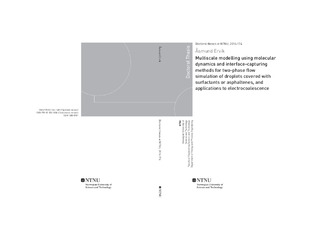| dc.contributor.author | Ervik, Åsmund | |
| dc.date.accessioned | 2016-07-11T10:43:08Z | |
| dc.date.available | 2016-07-11T10:43:08Z | |
| dc.date.issued | 2016 | |
| dc.identifier.isbn | 978-82-326-1686-2 | |
| dc.identifier.issn | 1503-8181 | |
| dc.identifier.uri | http://hdl.handle.net/11250/2396272 | |
| dc.description.abstract | THE WORK PRESENTED in this thesis attempts to improve our fundamental
understanding of the interfacial properties of water drops in
crude-oil. Model fluids consisting of aliphatic oil with surfactants, as well
as real crude components such as asphaltenes, are considered. The case of a
single drop being deformed, either by an electric field or by a needle deflating
the drop, is studied in detail using simulations. Close comparisons with
experiments are made, in order to increase confidence in the simulations
as a faithful representation of the physical world. Combining methods
at different scales, namely the molecular and the continuum, a simple but
effective multi-scale method is developed to predict and explain the behaviour
of drops with complex interfaces, e.g. water drops in oil covered with
asphaltenes.
The first part of this study concerns systems with a deforming drop
of water in a model oil with surfactant, where one has a more-or-less
complete understanding of the physics and chemistry. These systems are
studied in detail using computational fluid dynamics simulations, and direct
comparison with experiments is performed. The effect of surfactants on
the transient deformation of drops, and in particular on the damping of
oscillations, is studied here for the first time. To enable future studies of larger
systems with several drops interacting, a 3D parallel version of the code has
been developed using a domain decomposition approach. The case of a single
falling drop in the presence of surfactants is also considered with a theoretical
approach, and exact solutions are obtained for this system.
The second part is the multiscale simulations of systems with a
water drop in crude oil. The developed multiscale method consists of
coarse-grained molecular dynamics simulations, using the SAFT-
Mie
approach, which are used to provide interfacial properties for the continuum
simulations. At the continuum scale, a novel hybrid level-set/ghostfluid
/immersed-boundary method has been developed for the simulation
of complex fluid-fluid interfaces. Together, these approaches enable a direct
link between the chemical composition of the crude oil and the interfacial
properties. The molecular structure of crude oil components, and its effect
on interfacial properties, is still under debate in the literature. The simulation
approach developed here will enable detailed hypothesis testing, which may
help settle the debate. A configuration of particular interest in this context is
the “crumpling drop”, a phenomenon observed when a water drop in crude
oil is drained by means of a pipette. This system is simulated, and good
agreement is found with experiments reported in the literature.
For the coarse-grained molecular dynamics approach used in the
multiscale approach, namely the SAFT-
Mie force field, two computational
tools have been developed. They are called Bottled SAFT and raaSAFT.
Together they provide an unprecedented ease-of-use for obtaining models
for molecular simulation and for setting up and running these simulations. | nb_NO |
| dc.language.iso | eng | nb_NO |
| dc.publisher | NTNU | nb_NO |
| dc.relation.ispartofseries | Doctoral thesis at NTNU;2016:174 | |
| dc.relation.haspart | Paper 1: Ervik, Åsmund; Lervåg, Karl Yngve; Munkejord, Svend Tollak. A robust method for calculating interface curvature and normal vectors using an extracted local level set. Journal of Computational Physics 2014 ;Volum 257. s. 259-277
<a href="http://dx.doi.org/10.1016/j.jcp.2013.09.053" target="_blank"> http://dx.doi.org/10.1016/j.jcp.2013.09.053</a>
The article in is reprinted with kind permission from Elsevier, sciencedirect.com | nb_NO |
| dc.relation.haspart | Paper 2: Ervik, Åsmund; Munkejord, Svend Tollak; Müller, Bernhard. Extending a serial 3D two-phase CFD code to parallel execution over MPI by using the PETSc library for domain decomposition. I: Proceedings of the 10th International Conference on Computational Fluid Dynamics in the Oil & Gas, Metallurgical and Process Industries
<a href="http://arxiv.org/abs/1405.3805 " target="_blank"> http://arxiv.org/abs/1405.3805 </a> | nb_NO |
| dc.relation.haspart | Paper 3: Ervik, Åsmund; Hellesø, Svein Magne; Munkejord, Svend Tollak; Müller, Bernhard. Experimental and computational studies of water drops falling through model oil with surfactant and subjected to an electric field. The 18th IEEE International Conference on Dielectric Liquids; 2014 -
Is not included due to copyright available at
<a href="http://dx.doi.org/ 10.1109/ICDL.2014.6893172 " target="_blank"> http://dx.doi.org/10.1109/ICDL.2014.6893172 </a> | nb_NO |
| dc.relation.haspart | Paper 4:
Ervik, Å., Penne, T. E., Hellesø, S. M., Munkejord, S. T. & Müller, B.
Influence of surfactants on the electrohydrodynamic stretching of water
drops in oil. | nb_NO |
| dc.relation.haspart | Paper 5: Ervik, Å. & Bjørklund, E. The admissible surfactant distributions and velocities for small falling drops. Submitted to Journal of Fluid Mechanics, (2016) | nb_NO |
| dc.relation.haspart | Paper 6: raaSAFT: a framework enabling coarse-grained molecular dynamics simulations based on the SAFT- Mie force field. | nb_NO |
| dc.relation.haspart | Paper 7: Ervik, Å., Mejía, A. & Müller, E. A. Bottled SAFT: a web app providing SAFT- Mie force field parameters for thousands of molecular fluids. | nb_NO |
| dc.relation.haspart | Paper 8: Ervik, Å., Lysgaard, M. O., Herdes, C., Jiménez-Serratos, G., Müller, E. A., Munkejord, S. & Müller, B. A multiscale method for simulating fluid interfaces contaminated by large molecules such as asphaltenes. | nb_NO |
| dc.title | Multiscale modelling using molecular dynamics and interfacecapturing methods for two-phase flow simulation of droplets covered with surfactants or asphaltenes, and applications to electrocoalescence | nb_NO |
| dc.type | Doctoral thesis | nb_NO |
| dc.subject.nsi | VDP::Technology: 500::Environmental engineering: 610 | nb_NO |

